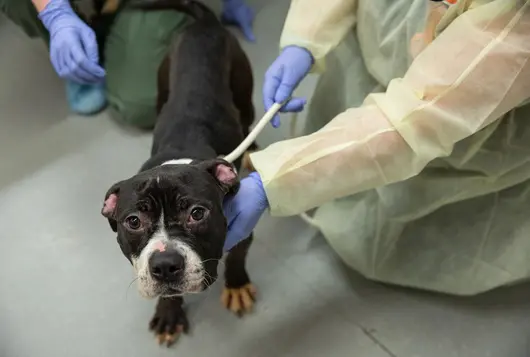Feeding Protocol & Nutrition Best Practices for Emaciated Dogs

Following a refeeding protocol is recommended for the first few days until the dog’s metabolism starts to transition back to a normal metabolism and food can be properly digested.
The goal is for the dog to maintain their current weight for the first 7 days by feeding the resting energy requirement (RER) of their intake weight (see Calculate the Resting Energy Requirement). If the dog is losing weight during this period, the dog should be re-examined, and the feeding amount should be increased. If the dog is gaining greater than 5% above their rehydrated entry weight during this period, the feeding amount should be reduced. Keep in mind that these dogs are frequently dehydrated, and part of their initial weight gain may be due to rehydration.
In the initial refeeding period, electrolytes should be used to evaluate the possibility of refeeding syndrome. Electrolyte changes consistent with refeeding syndrome include hypokalemia, hypophosphatemia, and hypomagnesemia. If these deficiencies are identified after food is introduced, they should be supplemented accordingly (for example, magnesium oxide tablets to correct hypomagnesemia at a dose of 1-2 mEq/kg/day). Empirical cobalamin and thiamine supplementation is recommended. Additionally, if the liver enzyme values on day 6 are elevated relative to the intake values, the food amount may be causing refeeding syndrome, and the amount may need to be decreased.
After an initial 7-day transition, the dog’s feeding amount can be increased to the daily energy requirement (DER) of their current weight: DER = RER x Factor; (see calculations under Feeding Protocol). This will support increased physical activity, and the dog may gain weight on this amount. The dog is fed at the DER of the current weight for 7 days.
If a dog is doing well on day 14, they should be increased to the DER of the ideal weight. Ideal weight is estimated to be 20-30% greater, depending on how emaciated they were on intake. Approximately 3-6 weeks later, a dog may need additional increases above 20-30%, depending on how much weight they have gained and their current body condition score. It is typical to re-evaluate and increase further, if needed.
Feeding Protocol
- Identify the Emaciated Dog: Use a consistent scale such as the 9-point Purina Body Condition Scale. A body condition score of 1, 2 or 3 should be identified as malnourished.
- Determine or Estimate Rehydrated Entry Weight: Dogs who are malnourished are also usually dehydrated. Estimate dehydration and determine the animal’s rehydrated entry weight. Example: A 20-kg malnourished dog estimated to be 10% dehydrated will have a rehydrated entry weight of 22 kg.
- Calculate the Resting Energy Requirement (RER): RER = body weight (kg)3/4 x 70. Example: For a 5 kg dog, RER = 53/4 x 70 = 234 kcal
- Calculate Feeding Amounts: Dogs who are malnourished should be fed:
- 33% (1/3) of their current weight (rehydrated) RER on the first day
- 66% (2/3) of their current weight (rehydrated) RER on the second day
- 100% of their current (rehydrated weight) on the third day. This amount should then be maintained for at least 7 days.
If an animal comes in with a history of eating, and it is unclear if the dog has been on a refeeding protocol, the animal can get started on RER of their current weight on presentation.
- Transition to the Daily Energy Requirement (DER): On Day 7, transition to the Daily Energy Requirement (DER): DER = RER x Factor
| Canine DER Calculation | |
|---|---|
| Canine Age | DER Calculation |
| Up to 4 months of age | RER x 3 |
| Over 4 months of age | RER x 2 |
| Average spay/neutered healthy adult | RER x 1.6 |
| Intact adult | RER x 1.8 |
- Vitamin Supplementation: Thiamine (vitamin B1) and cobalamin (vitamin B12) are empirically supplemented in all animals undergoing a refeeding protocol. Both of these B vitamins are water soluble and safe for empirical supplementation.
Thiamine is supplemented for the first 10 days of the refeeding protocol. Depending on product availability, medical staff availability, and patient tolerance, it can be administered orally or by injection. There is no standardized dose of thiamine for companion animals. The ASPCA has adopted the following dosing guidelines:
| Animal Weight | Injectable Thiamine | Oral Thiamine |
|---|---|---|
| Cats and small dogs <8kg | 50mg SQ SID | 100mg PO SID |
| Dogs >8kg | 100mg SQ SID | 200mg PO SID |
Cobalamin is supplemented according to the guidelines published on the Texas A&M Gastrointestinal Laboratory website. Injectable or oral cobalamin can be used. Injectable cobalamin is given for a total of 6 weeks. Oral cobalamin is administered for a total of 12 weeks.
Related Research
Learn more about the ASPCA research supporting our recommendations:
Using B12 Supplementation to Improve Quality of Life in Dogs
We have lots more on this subject:

